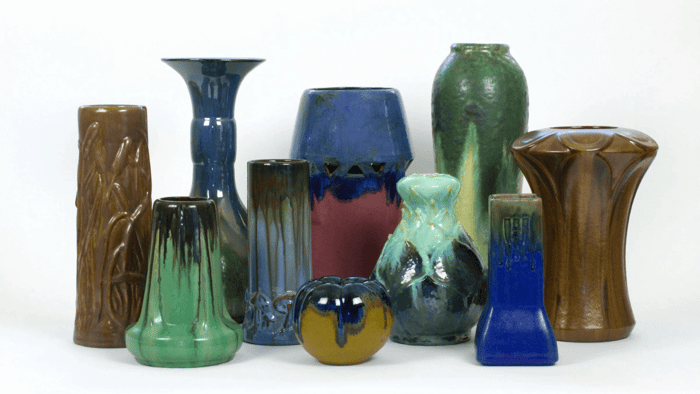The Fulper Pottery Company of Flemington, New Jersey produced a diverse line of art pottery, originally called Vasekraft, from 1909 to 1934. Although rarely dated, the pottery almost always carries Fulper marks, including ink stamps, in-mold and impressed logos, paper labels, and foil stickers. Because these marks were used for specific time periods, they can help identify production dates for individual pieces. Although previous publications have given approximate dates for some of the Fulper marks, many of these dates are inaccurate. The revised dates presented here are based on an extensive analysis of forms, marks, catalogs, advertisements, and period journals.
The Rectangular Ink mark (ca. 1909-1917) (Figs. 1a-e) was used on most forms produced from 1909 to 1917, including model Nos. 1 to 99, Nos. 400 to 560 and a few higher numbers, the Vasekraft lamps, and the “Gift Box” forms (Nos. 04 to 054). There are at least five different versions of the Rectangular Ink mark that vary in font style and size.
The Squat Rectangular Ink mark (ca. 1910-1916) (Fig. 2) is frequently found on forms with small bases, but it also appears on many larger forms, including some Vasekraft lamps.

The Rectangular and Squat Rectangular Ink marks are occasionally found with adjacent Letter and Symbol Ink marks (ca. 1910-1914) (Figs. 3a-d), which include uppercase and lowercase letters from A to Z and various other symbols. Although the exact purpose of these supplementary marks is not known, they appear to be associated with pieces carrying non-standard glazes for those particular forms.

The Vasekraft Ink mark (ca. 1911-1917) (Fig. 4) consists of the Vasekraft “Potter and his Wheel” trademark. The logo is based on a Fulper Pottery Co. photo, which apparently shows the longtime Fulper potter James M. Smith. This mark appears to be limited to Vasekraft lamps and the “Zwick” bottle form (model No. 34s).
The Early Oval Ink mark (ca. 1909-1911) (Figs. 5a-b) is frequently found on some of Fulper’s cookware forms, but it also appears occasionally on early Vasekraft forms. There are two versions of the mark that differ in shape and length. They are distinct from the later common Oval Ink mark, which was used on standard production forms during 1917-1934.
The Horizontal Raised mark (ca. 1910-1915) (Fig. 6) has only been observed on one particular Vasekraft bowl, which is part of a two-piece “Arrangeable Center Piece” (model No. 21).
Some Vasekraft pottery was produced with a Prang Ink mark (ca. 1913-1917) (Fig. 7) instead of a standard Fulper mark. The Prang Company was an art supply business that sold specific Fulper forms for use as drawing models.

Vasekraft pottery is sometimes found with one of three types of paper labels, which usually have hand-written information about the individual piece, including model number, form name, glaze name, and price. The Vasekraft Paper label (ca. 1911-1917) (Fig. 8), which is by far the most common of the three labels, incorporates the “Potter and his Wheel” trademark. The Early Vasekraft Paper label (ca. 1910-1911) (Fig. 9) and Round Vasekraft Paper label (ca. 1910-1911) (Fig. 10) lack the “Potter and his Wheel” trademark and have been found on very early Vasekraft forms.
Some Vasekraft pottery may carry the Panama-Pacific Paper label (ca. 1915-1917) (Fig. 11), which is usually found affixed to the sides of pieces. The label advertises the Medal of Honor that was awarded to Fulper at the renowned 1915 Panama-Pacific International Exposition in San Francisco.

By early 1917, Fulper’s advertisements no longer used the Vasekraft name and instead referred to the art pottery as simply “Fulper Pottery.” The advertisements also show that the Vasekraft trademark was replaced with the Fulper oval logo. This was now the principal trademark used in Fulper advertisements and catalogs. There was also a significant change in Fulper’s marking system shortly after the conclusion of the Vasekraft period. During 1917, the Rectangular Ink mark and Vasekraft Paper label were replaced with various marks incorporating the Fulper oval logo: Oval Raised, Oval Incised, Oval Ink, and the Fulper Paper label. The type of mark used on a piece was dependent on the form and the nature of its base. (1) Most new forms were made with the Oval Raised mark. (2) Many forms already in production were impressed with the Oval Incised mark. (3) Forms with bases unable to accommodate either the Oval Raised or Oval Incised mark were stamped with the Oval Ink mark.
The Oval Raised mark (ca. 1917-1923) (Fig. 12) is an in-mold mark used on nearly all forms with model numbers from 559 to 631. It was also used during 1910-1916 on certain Vasekraft pieces, including cookware shapes, special vases with a famille rose glaze, and a few other unique non-cataloged forms.
The Vertical Raised mark (ca. 1917-1920) (Fig. 13) is similar to the Oval Raised mark, but it lacks an oval border around the raised Fulper name. This in-mold mark is only found on vases with model numbers 583 and 584.
The Oval Incised mark (ca. 1917-1927) (Fig. 14) is an impressed mark that has the appearance of being hand-incised. It was first used in 1917 to replace the Rectangular Ink mark on many forms already in production. Subsequently, the mark was also used on many forms originally produced with an Oval Raised mark, on most forms introduced during 1922, and on a few forms introduced in 1926.
The Oval Ink mark (ca. 1917-1934) (Fig. 15) was used for the longest period of any Fulper mark. Initially, the Oval Ink mark was used primarily on forms with bases that could not fit the Oval Raised or Oval Incised marks, including twig sticks, flower holders, vases and bowls with narrow bases, forms with hollow bases, and bookends with flat bases. However, it would eventually become the predominant mark during 1924-1929 and continue as a secondary mark during 1930-1934.
The Fulper Paper label (ca. 1917-1927) (Fig. 16), which incorporates the Fulper oval logo, usually includes hand-written model number, form name, glaze name, and price.

After the destruction of the main Fulper pottery complex by fire on September 19, 1929, production of the art pottery line was shifted to the company’s other pottery plant in Flemington (“plant No. 2”). Fulper introduced the Horizontal Impressedmark (ca. 1929-1934) (Fig. 17) as its new principal mark when art pottery production resumed in late 1929. This mark was used on most forms with model Nos. 885 to 899, Nos. 4000 to 4089, and many earlier forms still produced after 1929. It is frequently found with an adjacent 3-digit or 4-digit model number. Although the Horizontal Impressed mark was the primary mark during 1930-1934, the Oval Ink mark was also used occasionally during this period.
The Horizontal In-Mold mark (ca. 1931-1934) (Fig. 18) was used on model Nos. 4050-4057 and appears with an adjacent in-mold model number. The font style and size of the mark varies on the different forms.
The Fulper Pottery In-Mold mark (ca. 1930-1932) (Fig. 19) has only been observed on the No. 828 ashtray.

The Fulper Pottery Foil label (ca. 1927-1934) (Figs. 20a-b) is occasionally found attached to the sides of pottery. There are two versions of this label that differ primarily in colors: (1) black with gold lettering, and (2) silver with black lettering. The black label was apparently used prior to the factory fire (ca. 1927-1929) and the silver label was used after production moved to plant No. 2 (ca. 1929-1934).
The gold and black 125th Anniversary Foil label (Fig. 21) was affixed to the sides of Fulper pottery in 1930. This label recognizes 1805 as the founding date for the first pottery company at the site in Flemington. Although Fulper advertisements frequently used the 1805 date, it has been determined that the pottery was actually established in 1814.

Author’s Note: This is an abridged version of an article published in the Winter 2017 issue of the Journal of the American Art Pottery Association. The original full-length article can be viewed and downloaded at Fulper.net.
About the Author: Jon A. Kornacki, Ph.D., is an independent scholar and longtime collector of Fulper pottery. He has published several articles on Fulper pottery in the Journal of the American Art Pottery Association. All the articles are available on Fulper.net, a website he created with his brother David W. Kornacki.
This article was provided to JustArtPottery.com with permission to share by the author.






